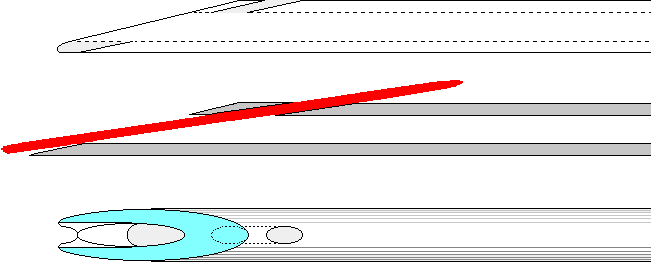Making Kit
Jeweled Sting Hook
|
|
|
|---|
|
Making Kit Jeweled Sting Hook |
Thoughts on Tubular Perforated Sting Hooks |
|---|
Perforated sting hooks for instrumental insemination of queen honey bees that can be manufactured from used insulin syringe needles.
These Thoughts were "brainstorming" suggestions back in year 2000... The only comments received were from John Pollard (who was enthusiastic about the idea), but neither I, nor he ever took them much further.
As a Diabetic I have to inject myself four times a day... The needles I use are thin and strong and I think they lend themselves to a slightly different approach which may speed up insemination work.
The standard 1.0 ml insulin needle tip is cemented directly into a disposable plastic syringe.

The tubular metal needle can be pulled free using pliers and a bit of a twisting action. Alternatively the metal needle can be heated with a soldering iron, in which case it pulls out effortlessly. The needle itself looks like this (when magnified):-

The modification consists of grinding the sharp tip away and cutting two grooves 0.15 mm wide (or drilling an oblique 0.15 mm hole) (existing perforated sting hooks have holes of this size and up to 0.2 mm), so our grooves could be up to 0.2 mm... The axial distance between the top and bottom grooves (or hole angle) is a matter for experiment.

The groove may be ground using a disc cut from a "blue" razor blade fitted to a "Dremel" mandrel and run in a paste made from pumice powder or Solvol Autosol (chrome cleaner).
Holes could be drilled by laser or spark eroded. I have no experience of laser drilling, but if I can find the time, I will do some research into spark erosion
 Once a needle has been prepared it can then be bent to shape... WHAT SHAPE is best?
Once a needle has been prepared it can then be bent to shape... WHAT SHAPE is best?
I have not been able to find any reason to depart from the shape of the existing type of perforated sting hook. The next sketch gives the profile of a tubular hook that has been bent to conventional shape. To avoid crushing the tube at the bends a piece of close fitting wire is inserted, but left short of the cut slots.
Whilst preparing the original text for this page, I have had further ideas... It may be possible to thread the sting axially into the end and through the hole in the type of tool described by the following sketch:-

 The sting rests in the groove in the lower part and a levering action pulls the vagina
straight in a similar fashion to the way tweezers or a normal perforated hook are used. The
blue colour indicates the original chamfer that was ground on the needle during original
manufacture as a syringe needle. Because the sting enters the original bore of the tube,
the angle of bend needs to be different in order that the hook guide rod itself is at a
more normal operating angle, as shown at right. The guide rod may need to be mounted further up
the post than with a normal sting hook.
The sting rests in the groove in the lower part and a levering action pulls the vagina
straight in a similar fashion to the way tweezers or a normal perforated hook are used. The
blue colour indicates the original chamfer that was ground on the needle during original
manufacture as a syringe needle. Because the sting enters the original bore of the tube,
the angle of bend needs to be different in order that the hook guide rod itself is at a
more normal operating angle, as shown at right. The guide rod may need to be mounted further up
the post than with a normal sting hook.
My only concerns about this design of perforated sting hook, is the lumen of the tube harbouring disease organisms, in order to minimise that, I would recommend that if it is cemented in place the lumen is filled with adhesive, but the safest way would be using the pin chuck and fully autoclaving all parts, including the pin chuck, in a disassembled condition.
Written... Late Summer 2000, Upgraded... 09, 10 June 2006,
|